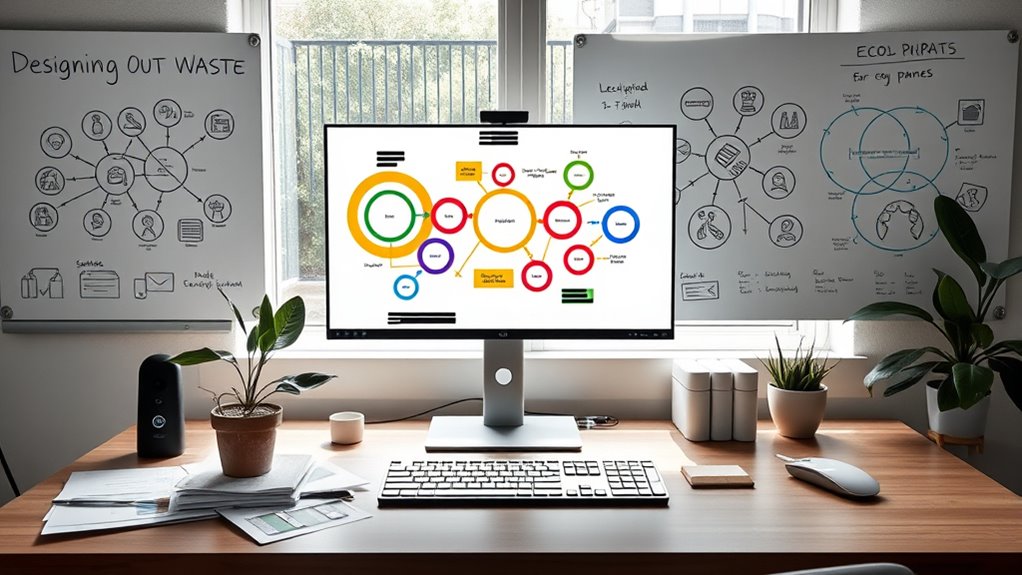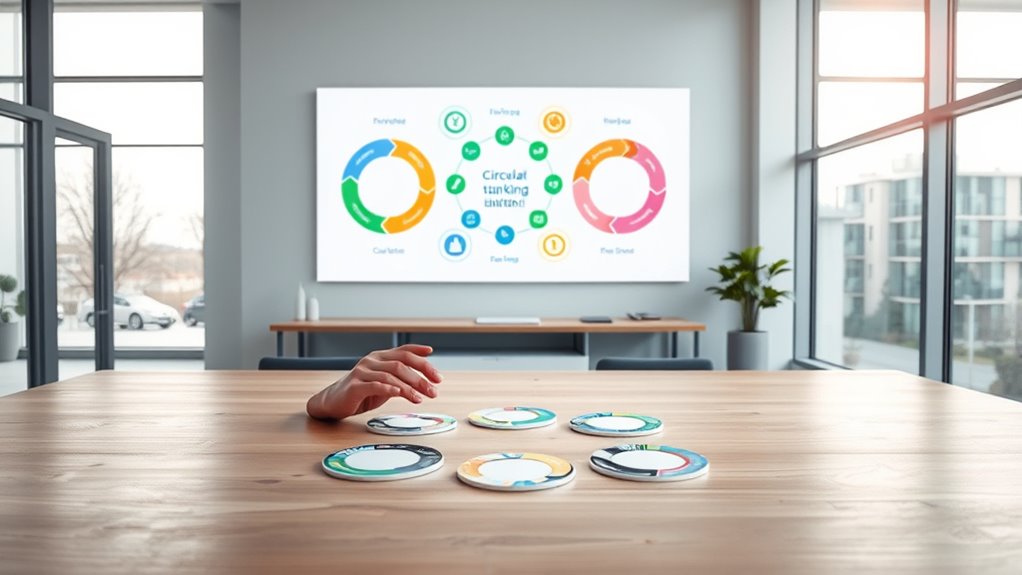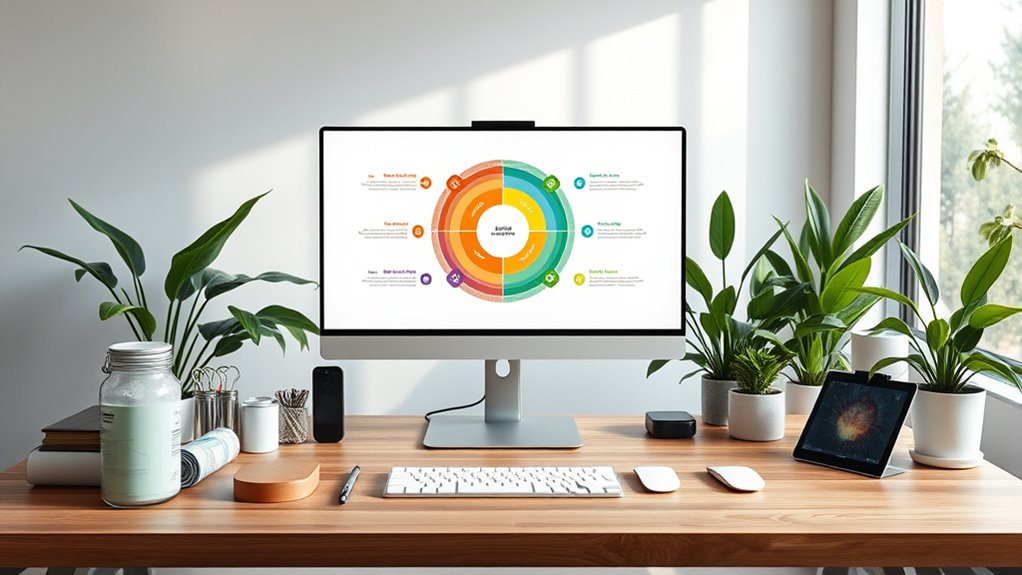To design out waste in digital products using circular thinking, focus on optimizing resource use, extending product lifespan, and reusing data and components whenever possible. Incorporate sustainable principles like modular design, repairability, and energy efficiency to reduce environmental impacts. By creating adaptable and durable digital solutions, you help prevent premature obsolescence and minimize waste. Exploring these strategies further can lead you to innovative ways to build a more sustainable digital ecosystem.
Key Takeaways
- Implement modular and upgradeable designs to facilitate product longevity and easy repairs, reducing digital waste.
- Promote data reuse and component repurposing across platforms to minimize resource consumption and waste generation.
- Incorporate sustainable development practices like eco-friendly interfaces and lightweight designs to optimize energy use.
- Adopt circular models emphasizing reuse, repair, and recycling of digital assets and code to extend product lifecycles.
- Design products with open standards and modular architectures that support future updates, adaptability, and reduced obsolescence.
Understanding Circular Thinking in the Digital Realm

Understanding circular thinking in the digital domain means recognizing how ideas, data, and processes often loop back on themselves, creating continuous feedback cycles. This approach encourages digital mindfulness—being aware of how your digital actions influence the entire data lifecycle. As data flows through collection, analysis, and storage, it can be reused, refined, or discarded in ways that minimize waste and inefficiency. You actively monitor how information is generated and utilized, ensuring that each step adds value rather than redundant effort. Circular thinking helps you see opportunities to close loops, optimize resource use, and foster sustainable digital practices. Recognizing the importance of data reuse can further enhance the longevity and sustainability of digital products by reducing unnecessary duplication and waste. By understanding these feedback cycles, you become more intentional about designing digital products that promote longevity, adaptability, and responsible data management.
The Environmental Impact of Digital Products

Digital products are deeply intertwined with environmental impact, as their development and use consume significant resources and energy. Manufacturing devices requires raw materials and contributes to resource depletion, while energy consumption during use adds to your carbon footprint. E waste management becomes essential, as discarded electronics can release harmful substances if not properly handled. The rapid turnover of devices increases electronic waste, posing environmental risks. Reducing this impact involves designing products that last longer, are easier to upgrade, and are recyclable. By being mindful of these factors, you can help minimize environmental harm. electronic waste management is crucial for reducing the environmental footprint of digital products, as improper disposal can lead to soil and water contamination. Smart choices in digital product use and disposal directly influence e waste management efforts and lower your carbon footprint, making a tangible difference in protecting the planet.
Principles of Designing Out Waste

Designing out waste starts with rethinking how products are created, used, and disposed of from the very beginning. One key principle is promoting digital reuse, which extends the lifespan of digital assets and decreases unnecessary duplication. Instead of constantly creating new data or applications, focus on optimizing existing resources for multiple uses. Cloud optimization is another essential principle; by efficiently managing cloud infrastructure, you minimize energy consumption and hardware waste. This approach ensures that digital environments are scalable, cost-effective, and environmentally responsible. Prioritizing sustainable design practices can further reduce environmental impact by embedding eco-friendly principles into the entire development process. You should also prioritize modular design, making updates or changes easier without overhauling entire systems. Implementing these principles helps you reduce digital waste, conserve resources, and foster a more sustainable digital ecosystem.
Strategies for Sustainable Digital Design

Building on the principles of reducing waste, adopting practical strategies can substantially enhance the sustainability of your digital products. Focus on digital reuse by designing components that can be repurposed across platforms, reducing the need to create new assets from scratch. Use eco-friendly interfaces that minimize energy consumption, such as optimizing images and streamlining code. Prioritize lightweight design, which decreases data transfer and device processing power, further cutting down environmental impact. Incorporate user-centered design to extend product lifespan, encouraging users to engage longer with your digital solutions. Additionally, implement features that promote longevity, like customizable elements and modular updates. These strategies help you create more sustainable digital products that are both environmentally responsible and user-friendly. Regional bank operating hours can vary, so understanding local schedules supports better planning and resource management.
Implementing Circular Models in Software Development

Implementing circular models in software development involves rethinking traditional workflows to prioritize reuse, repair, and recycling of code and resources. You’ll focus on data minimization, collecting only what’s essential to reduce waste and improve efficiency. Incorporate user-centered design by involving users early to create flexible, adaptable solutions that can evolve over time. This approach encourages modular code, making it easier to update, repurpose, or repair components instead of starting from scratch. Emphasizing data minimization reduces storage needs and processing power, aligning with sustainability goals. Additionally, understanding privacy policies helps ensure that data collection practices respect user privacy and comply with regulations. By integrating these principles, you foster a more sustainable development process that minimizes waste, extends product lifespan, and aligns with circular economy values. This method helps you build resilient, resource-efficient digital products.
Case Studies of Circular Digital Products

Several digital products exemplify circular principles in action, demonstrating how sustainability and efficiency can coexist in technology. For instance, some cloud platforms optimize resource use through data reuse, reducing unnecessary storage and processing. By repurposing existing data, these products minimize waste and enhance system longevity. Cloud optimization strategies enable businesses to scale their digital services without increasing environmental impact, ensuring energy is used efficiently. One notable example is a data analytics platform that reuses historical datasets for new insights, cutting down on redundant data collection. These case studies highlight how circular digital products prioritize reuse and resource efficiency, proving that sustainable design can deliver high performance. Such approaches set a precedent for future innovations, showing that digital transformation and environmental responsibility go hand in hand. Additionally, implementing resource-efficient practices in development processes further supports sustainability goals and extends the lifespan of digital infrastructure.
Challenges and Opportunities in Circular Digital Design

What are the key hurdles and promising opportunities in designing circular digital products? One challenge is balancing digital reuse with maintaining quality and security. Reusing digital assets can reduce waste, but it requires careful management to avoid data breaches or degraded functionality. Data minimization offers an opportunity to streamline systems, reducing unnecessary storage and processing, which benefits both sustainability and user privacy. However, implementing data minimization can be complex, especially when balancing user needs and regulatory requirements. Another hurdle is encouraging organizations to shift from linear to circular thinking, which involves changing established workflows and mindsets. Yet, these challenges also open doors for innovation—such as developing smarter reuse strategies and designing systems that inherently prioritize minimal data use—creating a more sustainable digital ecosystem. Incorporating projector technology concepts like high contrast ratios and color accuracy into digital design can further enhance user experience while supporting sustainability goals.
Future Trends Toward a Sustainable Digital Ecosystem

As organizations recognize the benefits and challenges of circular digital design, the focus shifts toward shaping a sustainable digital ecosystem through emerging trends. Data reuse becomes central, enabling systems to maximize resources and reduce waste by repurposing existing digital assets. This practice minimizes the need for continuous new data creation, supporting longevity and adaptability. Additionally, addressing digital obsolescence is critical; innovation now emphasizes designing products that can evolve and remain relevant longer, preventing premature disposal. Trends like modular architectures and open standards facilitate this, allowing updates and integrations without replacing entire systems. Incorporating Kia Tuning techniques such as ECU remapping and suspension upgrades can extend the lifespan of vehicles and digital systems alike, promoting sustainability. By prioritizing data reuse and combating digital obsolescence, you can contribute to a resilient, sustainable digital future that minimizes waste and maximizes value across the ecosystem.
Frequently Asked Questions
How Can User Behavior Influence Circular Digital Product Design?
User behavior greatly influences circular digital product design by shaping how you engage and interact with products. Your feedback loops provide valuable insights, guiding designers to create more sustainable solutions. When you actively participate through feedback, you help establish patterns that promote reuse, recycling, and efficiency. Your engagement encourages developers to refine features and reduce waste, ultimately fostering a cycle of continuous improvement aligned with sustainable, circular design principles.
What Role Does Data Management Play in Reducing Digital Waste?
You play a vital role in reducing digital waste through effective data management. By implementing strong data governance, you guarantee data quality and compliance, preventing unnecessary storage and processing. Metadata management helps you organize and track data efficiently, making it easier to identify redundant or outdated information. Together, these practices enable you to optimize digital resources, minimize waste, and promote a more sustainable and circular approach to digital product design.
Are There Specific Tools to Measure Circularity in Digital Projects?
You can measure circularity in digital projects using tools that focus on lifecycle assessment and circularity metrics. These tools evaluate how well your project minimizes waste, extends product life, and encourages reuse or recycling. By analyzing data on resource flow and environmental impact, you gain insights to improve sustainability. Implementing these tools helps you track progress toward circularity, making your digital projects more eco-friendly and aligned with circular thinking principles.
How Can Businesses Incentivize Sustainable Digital Practices?
Oh, sure, convincing your team to go green is as easy as offering a gold star, right? You can incentivize sustainable digital practices by offering eco-friendly incentives like green certifications or bonuses for eco-conscious innovations. These rewards motivate employees and signal your commitment to sustainability. Remember, a little recognition goes a long way—turn your digital eco-warriors into champions of circular thinking, and watch your business become a beacon of green excellence.
What Are the Economic Benefits of Adopting Circular Digital Strategies?
You can see that adopting circular digital strategies offers clear economic benefits, like boosting digital monetization opportunities and reducing costs. By reusing and recycling digital resources, you cut down on waste and operational expenses. This approach not only enhances your profitability but also creates a sustainable business model. Embracing circular thinking helps you stay competitive, attract eco-conscious customers, and maximize revenue streams while minimizing resource expenditure.
Conclusion
By adopting circular thinking, you can profoundly reduce digital waste—did you know that e-waste generates over 50 million tons globally each year? Embracing sustainable design principles not only benefits the environment but also boosts innovation and efficiency in your digital projects. As you move forward, integrating circular models can help create a more sustainable digital ecosystem, ensuring your work contributes positively to the planet’s future while meeting user needs effectively.









